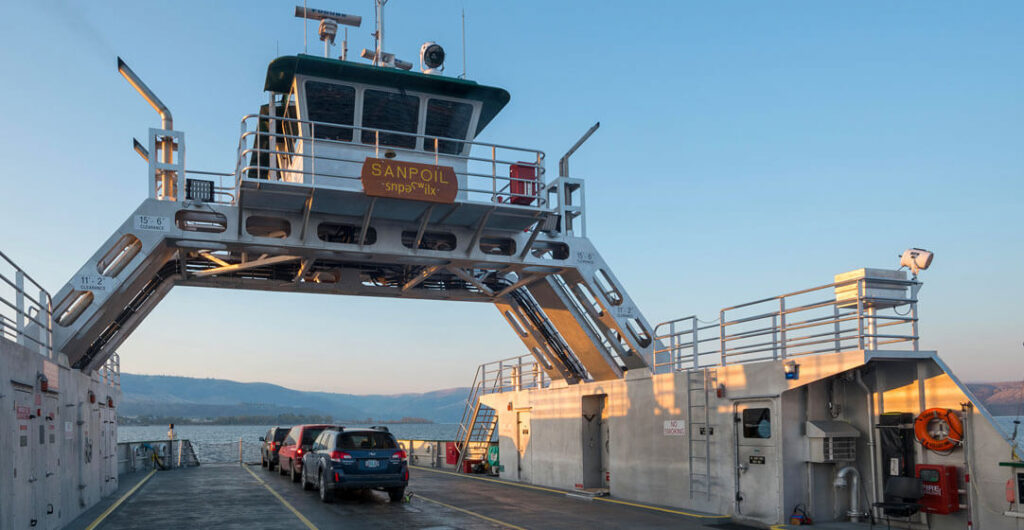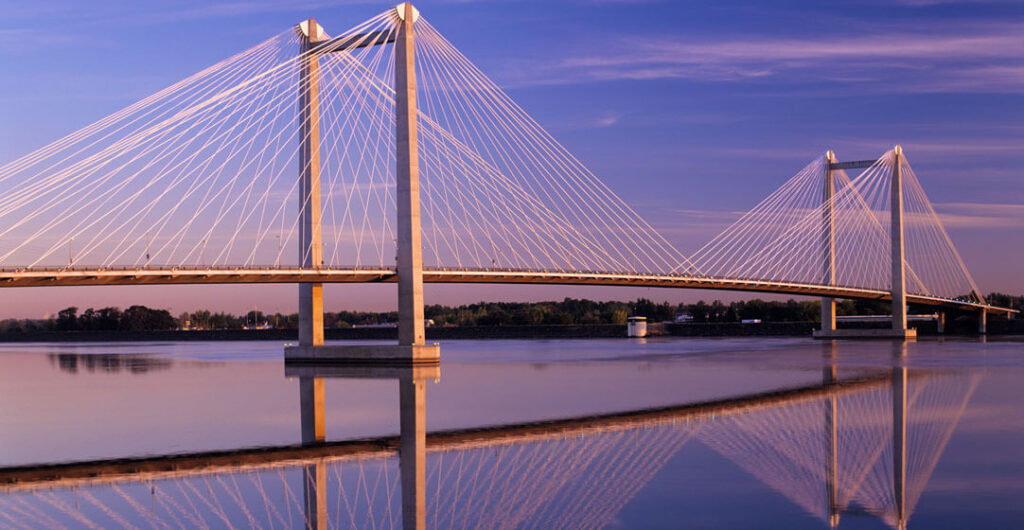Experience the ferries and bridges across the Pacific Northwest’s great river
Fed by glacial waters in the Canadian Rockies, the mighty Columbia River meanders through the channeled scablands of Eastern Washington. Without warning, the river beelines west to the salty water of the Pacific Ocean, passing towering, tree-lined waterfalls. By the time it reaches the tumultuous swells of the Pacific, the Columbia River has traveled 1,243 miles, making it the largest North American river that flows to the Pacific. Huge in size and importance, the Columbia is the lifeblood of the Pacific Northwest.
The Columbia has a drainage basin roughly the size of France, filling with runoff from seven states and British Columbia. For millennia, the river was a watery highway, bringing together Indigenous populations from around the West. Before the westward expansion and dams forever changed the landscape, the Columbia was a source of food and rich culture for the first peoples. They would cross in canoes and trade goods from all around the West, fishing for salmon at the rapids and traveling up and down the river.

Columbia River Ferries
In 1805, Lewis and Clark encountered the river and saw its value, using it to race west to the ocean. All along the muddy banks of the river, ferry services proliferated through the 1800s, helping to bring together the opposite sides of the river. The reliance on the river’s water for transportation started to wane in 1887, when the first railroad bridge crossed the Columbia at Kennewick. It would take decades but through the 1900s, the number of ferries decreased as bridges popped up over the increasingly controlled waters of the Columbia.
Today we have many options to cross the Columbia River, each of which are located near recreation destinations and towns rich in culture and history. Only three ferry options remain. Connecting Washington’s Puget Island with Oregon near the Clatsop State Forest, the Cathlamet-Westport Ferry has been in operation since 1925 and is a unique way to head out to the Oregon Coast. You also get to drive over a short bridge spanning the Columbia to reach the ferry from Puget Island. To make a full-day adventure, visit Astoria and the Lewis and Clark National Historical Park, cross the Astoria-Megler Bridge and stop off at Dismal Nitch before completing the loop.
East of the Cascades, Washington State Ferries operates the Keller Ferry, linking together state Route 21. Above Lake Roosevelt, the Confederated Tribes of the Colville Reservation operate the Gifford-Inchelium Ferry. Take both ferries and complete a scenic loop around a largely overlooked section of Washington.

Drivable Bridges
Ferry crossings are few and far between, but nearly two dozen bridges now span the Columbia and are often located at historic ferry crossing sites. From the small bridge at Northport by the Canadian border all the way down to the massive bridge near the mouth of the river near Astoria, each crossing is unique.
In 1908, the first automobile bridge was completed, spanning the Columbia in Wenatchee. Replaced in 1950 to accommodate more traffic and larger automobiles, the new bridge is part of Highway 28/285 and connects Wenatchee with East Wenatchee. From Hale Park, you can cross the old bridge on foot as part of the Apple Capital Loop Trail. North of town, find Wenatchee’s second bridge, spanning the river on U.S. 2 where the historic Burch Ferry once ran.
North of Wenatchee near Chelan, the Beebe Bridge has crossed the Columbia for more than 100 years. Originally, the suspension bridge was used as an irrigation pipeline for the Beebe Orchard Co. of Boston but was transitioned into a toll bridge in 1919. The original bridge was replaced in 1963, but its concrete towers can still be seen in the water just south of the new bridge. North of the Beebe Bridge, find five more bridges, many of which run across the river where ferries used to cross.
South of Wenatchee, we find the Columbia River crossing at Vantage. Replacing a ferry line that started in 1914, the original Vantage Bridge was completed in 1927 and the current I-90 bridge that replaced the original was opened in 1962. Visible from the Ginkgo Petrified Forest, the Vantage boat launch as well as the Wild Horse Scenic View and Scenic Overlook of the Columbia, the bridge is framed by the incredible geology of the Columbia Gorge. Thirty-one miles downstream, encounter the Vernita Bridge, which carries state Route 24. Nearby, find the Wanapum Heritage Center, Hanford Reach National Monument and the Manhattan Project National Historic Site.
Roughly 50 miles south, three bridges cross the Columbia in the Tri-Cities, including the scenic Cable and Blue bridges. The Ed Hendler Bridge, known as the Cable Bridge, opened in 1978 as a replacement of the original 1922 Pasco-Kennewick crossing. You still can see a section of the old bridge at the East Benton County Museum in Kennewick. And while you are in the neighborhood, stop by the Franklin County Historical Society and Museum in Pasco, which has an extensive collection of artifacts relative to the county’s history.
As you continue down the Columbia, the Umatilla Bridge crosses into Oregon via U.S. 82. The Biggs Rapids Bridge, also known as the Sam Hill Memorial Bridge, is next. Offering unique stops on the Washington side, including a Stonehenge replica and the amazing Maryhill Museum of Art, stop here before heading west toward to the Pacific.

Crossing into Oregon
Along the Columbia River Gorge, bridges connect Washington and Oregon allowing drivers to access world-renowned waterfalls and spring wildflower wonderlands. One highlight is the Bridge of the Gods 40 miles from Portland. Dry Creek Falls is nearby, which drops about 230 feet in five stages. Opened in 1926 and later rebuilt, the toll bridge is an official part of the hiking and equestrian Pacific Crest Trail. East of the Bridge of the Gods, the Hood River Bridge also collects a toll, while The Dalles Bridge is free. At The Dalles, learn more about the region’s history by visiting the Columbia Gorge Discovery Center and Museum.
The two most traveled bridges over the Columbia, averaging nearly 300,000 crossings a day, connect Vancouver and Portland. The Interstate Bridge, originally built in 1917, was the first bridge across the Lower Columbia River. To the east, the Glenn L. Jackson Memorial Bridge has been in operation since 1982. On rare occasions this part of the river will freeze over in large sections near Vancouver and Portland. The last time it froze nearly solid was 1930, and people walked across, rode bikes and even drove their cars on the ice, bypassing the nearby bridge for a once-in-a-lifetime experience.
Farther west, the pace of the Columbia and the number of people on the bridges slows. As the river widens, the bridges become longer. The mile-and-a-half-long Lewis and Clark Bridge at Longview was designed by Joseph Strauss, chief engineer of the Golden Gate Bridge. Even longer in distance is the Astoria-Megler Bridge. Completed in 1966, the bridge is a whopping 4.1 miles long and reaches a height of 200 feet above the water. Driving across is an excellent experience. For the most impressive view of the bridge and river, head up to The Astoria Column, a tower overlooking the Columbia’s mouth, and enjoy a panoramic wonderland.
—Written by Douglas Scott
—Top photo is a view of the Columbia Gorge by Nick Imbery
—Originally published in the 2022 Fall Edition of AAA Washington’s member magazine, Journey.

Road Trip Tips
Before you go: Get ready for your road trip with a AAA Membership. Get peace-of-mind on the road plus travel and insurance services and much more.
Save on hotels and rental cars: Unlock savings on hotels with a AAA membership. Plus, AAA members save up to 20% with Hertz.
Save on car insurance: AAA members save up to 8% on car insurance.
Get battery service: AAA Mobile Battery Service uses state-of-the-art technology to accurately diagnose battery-related problems. We’ll even replace your battery with a brand-new one if necessary, at a special member price.
Save with AAA member discounts: AAA membership gives you access to exclusive entertainment discounts nationwide.









